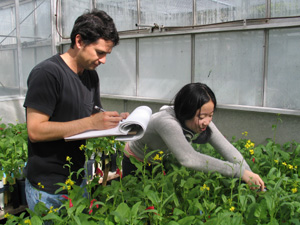Evolution in response to climate change
We are now experiencing substantial changes in the earth?s climate, with warmer temperatures, droughts, and other changes in precipitation patterns found world-wide. Many reports tell of ecological changes brought about by these climatic shifts, but will climate change bring about evolutionary changes in wild plants and other species?
 To investigate this question, Steve Franks, Sheina Sim and Art Weis, scientists at the University of California, Irvine, studied flowering time in field mustard. They found that following a natural drought in southern California, plants flowered as much as 9 days earlier than pre-drought plants, allowing them to escape drought conditions. The findings were reported January 12, 2007 in the journal Proceedings of the National Academy of Sciences.
To investigate this question, Steve Franks, Sheina Sim and Art Weis, scientists at the University of California, Irvine, studied flowering time in field mustard. They found that following a natural drought in southern California, plants flowered as much as 9 days earlier than pre-drought plants, allowing them to escape drought conditions. The findings were reported January 12, 2007 in the journal Proceedings of the National Academy of Sciences.
Figure: First author and UCI postdoc Steve Franks (left) and former student, second author, and current laboratory technician at the Max Plank Institute in Halle, Germany Sheina Sim measure plants to determine the genetic basis of flowering time and the evolutionary changes in this trait following drought.
The study shows extremely rapid evolution in a natural population. The shift in flowering time occurred within 7 years of drought. This counters the notion that evolution is a slow and gradual process.
Franks and his colleagues used a unique experimental method to detect this rapid evolutionary response. They collected seeds before and after the drought, grew them in the greenhouse, and raised their offspring under controlled conditions. By examining flowering time from the offspring of these crosses, the scientists could show that the shift in flowering time was genetically based. This would not have been possible if changes in flowering time had simply been observed in natural populations.
The study showed not only that flowering time shifted but that plants with earlier flowering time performed better under drought conditions. Plants were raised under conditions that simulated drought, and the earlier flowering plants had higher fitness (survival and seed production) than plants that flowered later. Thus not only did flowering time shift after the natural drought, this shift in flowering time represented an episode of adaptive evolution, which allowed the plants to complete their life-cycle and produce offspring before running out of water.
While field mustard was able to rapidly evolve earlier flowering time in response to the drought, this does not mean that all species will be able to compensate for climate change through adaptive evolution. Field mustard is a weedy, annual plant, and such fast-growing species are likely to evolve much more quickly than slow growing species. While the study did not address this question directly, climate change could thus potentially favor more weedy species over slow-growing native plants. Also, even if species show an evolutionary response to an initial change in climate, the species may eventually run out of genetic variation or face other developmental or physiological constraints that will prevent them from evolving with further climate change. Finally, while gradual changes in climate may allow for evolution, if catastrophic events occur, as predicted in some climate models, species will be unlikely to be able to evolve to deal with such disasters. Instead, massive extinctions, as seen several times earlier in earth’s history with dramatic changes in climate, are a real possibility.
The scientists involved with this study are following up on the results in several ways. Steve Franks is currently investigating why the shift in flowering time was so rapid. The fact that individuals mate according to flowering time is one possibility under study. He is also examining how the changes in flowering time shown in this study may affect the exchange of genes among populations. The resulting shift in gene flow is likely to have important consequences for evolutionary and population dynamics. Sheina Sim is studying ecological genetics in the related plant Arabidopsis thaliana in a collaborative project with field sites throughout Europe and North America. She is currently based at the Max Plank institute in Cologne, Germany. That group is investigating genes involved in photoperiod sensitivity and other traits of ecological importance. Art Weis, as the new director of the University of Toronto’s Koffler Research Reserve, will be spearheading ‘Project Baseline.’ In this project, methods similar to that used the field mustard study will be expanded to include many additional species. Scientists will create extensive collections of seeds and propagules of these species at multiple times over the coming decades and maintain the collections in storage. Decades from now, future scientists will “resurrect” theses ancestral generations and compare them to their future descendants. With expected advances in DNA technology, these future experiments will offer an unprecedented opportunity to study the genetic basis of evolution.
Francks S. et al., Proceedings of the National Academy of Sciences, January 12, 2007






